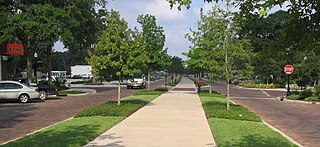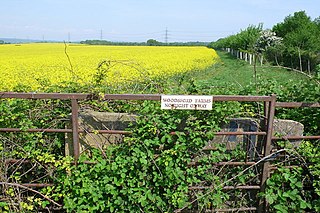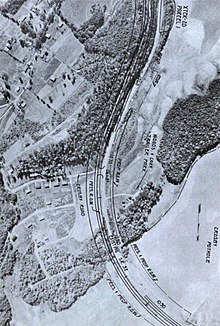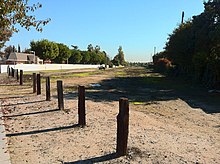
Trail riding is riding outdoors on trails, bridle paths, and forest roads, but not on roads regularly used by motorised traffic. A trail ride can be of any length, including a long distance, multi-day trip. It originated with horse riding, and in North America, the equestrian form is usually called "trail riding," or, less often "hacking." In the UK and Europe, the practice is usually called horse or pony trekking.

A towpath is a road or trail on the bank of a river, canal, or other inland waterway. The purpose of a towpath is to allow a land vehicle, beasts of burden, or a team of human pullers to tow a boat, often a barge. This mode of transport was common where sailing was impractical due to tunnels and bridges, unfavourable winds, or the narrowness of the channel.

A trail, also known as a path or track, is an unpaved lane or a small paved road not intended for usage by motorized vehicles, usually passing through a natural area. In the United Kingdom and Ireland, a path or footpath is the preferred term for a pedestrian or hiking trail. The term is also applied in North America to accompanying routes along rivers, and sometimes to highways. In the US, the term was historically used for a route into or through wild territory used by explorers and migrants. In the United States, "trace" is a synonym for trail, as in Natchez Trace.
Railbanking is the practice of preserving rail corridors for possible future use. Railbanking leaves the railroad, railbed, bridges or bridge corridor, and other infrastructure intact. This relieves the railroad's operator from the responsibility of maintenance, and from taxation. Existing rails may or may not be maintained intact on the railbed, depending on their condition or any planned interim use of the railbed. Often the rail corridor is put in custody of a state transportation agency, which then seeks a new operator for possible rehabilitation or reactivation. This helps ensure the possibility of future restored rail service when new economic conditions may warrant resuming operation.
Right of way may refer to:

A footpath is a type of thoroughfare that is intended for use only by pedestrians and not other forms of traffic such as motorized vehicles, bicycles and horses. They can be found in a wide variety of places, from the centre of cities, to farmland, to mountain ridges. Urban footpaths are usually paved, may have steps, and can be called alleys, lanes, steps, etc.

The freedom to roam, or "everyman's right", is the general public's right to access certain public or privately owned land, lakes, and rivers for recreation and exercise. The right is sometimes called the right of public access to the wilderness or the "right to roam".

A green lane is a type of road in the United Kingdom, usually an unmetalled or unpaved rural route.

A rail trail is a shared-use path on railway right of way. Rail trails are typically constructed after a railway has been abandoned and the track has been removed but may also share the right of way with active railways, light rail, or streetcars, or with disused track. As shared-use paths, rail trails are primarily for non-motorized traffic including pedestrians, bicycles, horseback riders, skaters, and cross-country skiers, although snowmobiles and ATVs may be allowed. The characteristics of abandoned railways—gentle grades, well-engineered rights of way and structures, and passage through historical areas—lend themselves to rail trails and account for their popularity. Many rail trails are long-distance trails, while some shorter rail trails are known as greenways or linear parks.

The West Orange Trail is a 22-mile (35 km) long multi-use rail trail owned by Orange County Parks and Recreation in Orange County, Florida, in the United States. The paved trail passes through downtown Oakland, Winter Garden, and Apopka with most of its length built on old railroad alignments. To the west of the West Orange Trail is the South Lake-Lake Minneola Scenic Trail in Lake County which was connected to the trail in 2007.
A thoroughfare is a primary passage or way as a transit route through regularly trafficked areas, whether by road on dry land or, by extension, via watercraft or aircraft. Originally, the word referred to a main road or open street which was frequented thoroughly.

A greenway is usually a shared-use path along a strip of undeveloped land, in an urban or rural area, set aside for recreational use or environmental protection. Greenways are frequently created out of disused railways, canal towpaths, utility company rights of way, or derelict industrial land. Greenways can also be linear parks, and can serve as wildlife corridors. The path's surface may be paved and often serves multiple users: walkers, runners, bicyclists, skaters and hikers. A characteristic of greenways, as defined by the European Greenways Association, is "ease of passage": that is that they have "either low or zero gradient", so that they can be used by all "types of users, including mobility impaired people".
The Klickitat Trail is a 31-mile (50 km) rail trail along the Klickitat River in southern Washington in the Columbia River Gorge. The cycling and hiking trail offers river and canyon views throughout its length. It follows an old railroad corridor that at one time linked the towns of Lyle and Goldendale.

A bridle path, also bridleway, equestrian trail, horse riding path, ride, bridle road, or horse trail, is a trail or a thoroughfare that is used by people riding on horses. Trails originally created for use by horses often now serve a wider range of users, including equestrians, hikers, and cyclists. Such paths are either impassable for motorized vehicles, or vehicles are banned. The laws relating to allowable uses vary from country to country.

The Genesee Valley Greenway is a rail trail in western New York's Genesee River valley.
An easement is a nonpossessory right to use and/or enter onto the real property of another without possessing it. It is "best typified in the right of way which one landowner, A, may enjoy over the land of another, B". An easement is a property right and type of incorporeal property in itself at common law in most jurisdictions.

Right of way, a specific type of easement, is a legal term used in a variety of related ways. It can be a right, established by grant from a landowner or long usage, to pass along a specific route through property belonging to another. Access granted by a right of way ranges from being broad enough to grant access to the general public, to being restricted for the benefit of only a specific individual or adjacent property.
Preseault v. United States was a notable US court case involving Rail to Trails programs in the state of Vermont. The case involved the scope of the government's ownership in public interests it had abandoned years prior to its decision to reuse the property for another task without considering the land-owners rights.
Marvin Brandt Revocable Trust v. United States, 572 U.S. 93 (2014), was a United States Supreme Court case in which the Court held that a railroad right-of-way granted under the General Railroad Right-of-Way Act of 1875 is an easement. Therefore, when a railroad abandons such a right-of-way, the easement disappears, and the land owner regains unburdened use of the land.

Terminology related to road transport—the transport of passengers or goods on paved routes between places—is diverse, with variation between dialects of English. There may also be regional differences within a single country, and some terms differ based on the side of the road traffic drives on. This glossary is an alphabetical listing of road transport terms.
















